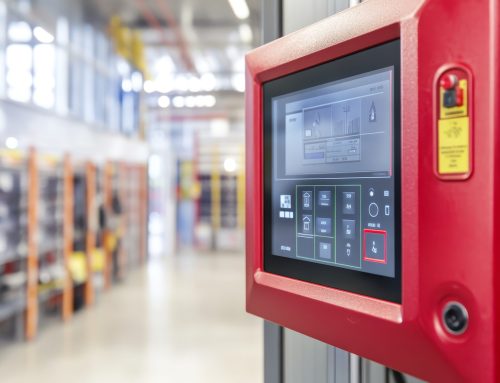Two common types of fire alarm systems used in commercial settings are conventional and addressable systems. Fire alarm systems are crucial components of any commercial building’s safety infrastructure. They serve as early warning systems, detecting and alerting occupants to the presence of fire, thereby saving lives and minimizing property damage. In this article, we’ll explore the key differences between conventional vs addressable commercial fire alarm systems to help you make informed decisions about fire safety for your commercial property.
What are Conventional Fire Alarm Systems?
Conventional fire alarm systems are the traditional type of fire detection system commonly found in older commercial buildings and smaller establishments. They consist of a series of interconnected devices, such as smoke detectors, heat detectors, and manual pull stations, wired to a central control panel.
Wiring and zones
In a conventional system, the building is divided into zones, with each zone connected to a specific circuit on the control panel. When a fire alarm device in a particular zone is triggered, it sends a signal to the control panel, which in turn activates alarms in that zone.
Indication of alarm location
Conventional systems provide limited information about the location of a fire. Since each zone encompasses multiple devices, the control panel can only identify the general area where the alarm was activated, such as “Zone 1” or “Zone 2.”
What are the Pros and Cons of a Conventional Fire Alarm System?
Pros
- Cost-effective: Conventional systems are typically less expensive to install than addressable systems, making them a more budget-friendly option for small businesses or buildings with simple layouts.
- Simple: Conventional systems are straightforward in design and operation, making them easy to understand and maintain.
- Widely availabile: Conventional fire alarm components are widely available, making them accessible for installation and replacement in a variety of settings.
- Reliable detection: Conventional systems provide reliable fire detection within predefined zones, ensuring that alarms are triggered even in the absence of advanced features.
Cons
- Maintenance and troubleshooting: Troubleshooting and maintenance of conventional systems can be more challenging and time-consuming due to their limited ability to pinpoint the exact location of a fire alarm activation. Technicians must manually inspect each device within the activated zone to identify the source of the alarm.
- Limited information: Conventional systems provide limited information about the location of a fire, making it challenging to pinpoint the exact source of an alarm activation.
- Zone-based alarming: Alarms in conventional systems are activated by zone, which can lead to delays in identifying the specific area affected by a fire.
- False alarms: Conventional systems may be more prone to false alarms due to their inability to distinguish between different types of alarm signals within a zone.
What are Addressable Fire Alarm Systems?
Addressable fire alarm systems represent a more advanced and sophisticated approach to fire detection and notification. These systems offer enhanced functionality and flexibility, making them ideal for larger commercial buildings and facilities with complex layouts.
Individual device identification
Unlike conventional systems, addressable systems allow for the individual identification and address assignment of each fire alarm device. Each device, such as a smoke detector or pull station, has a unique address programmed into the system.
Precise location identification
With addressable systems, the control panel can pinpoint the exact location of a triggered alarm down to the specific device that detected the fire. This level of detail enables faster response times and more effective evacuation procedures.
Wiring and communication
Addressable systems use digital communication protocols, such as multiplexing or loop wiring, to connect devices to the control panel. This allows for more efficient data transmission and greater reliability compared to conventional systems.
What are the Pros and Cons of an Addressable Fire Alarm System?
Pros
- Zone flexibility: Addressable systems offer greater flexibility in zoning, allowing building owners and managers to customize alarm zones based on the building’s layout and occupancy. This flexibility facilitates easier system management and reduces the risk of false alarms.
- Advanced features: Addressable systems often come equipped with advanced features such as self-testing capabilities, event logging, and remote monitoring. These features enhance system reliability, simplify maintenance tasks, and provide valuable data for post-incident analysis.
- Scalability: Addressable systems are scalable and can easily accommodate expansions or modifications to the building layout, making them suitable for larger or more complex commercial properties.
- Precise location identification: Addressable systems can pinpoint the exact location of a fire alarm activation down to the specific device, enabling faster response times and more effective evacuation procedures.
Cons
- Higher cost: Addressable systems tend to be more expensive to install and maintain than conventional systems due to their advanced features and digital communication protocols.
- Complex: Addressable systems are more complex in design and operation, requiring specialized training for installation, programming, and troubleshooting.
- Compatibility issues: Integrating addressable systems with existing fire alarm infrastructure or other building systems may pose compatibility challenges, requiring additional investment and expertise.
- Reliance on power supply: Addressable systems rely on a continuous power supply to function effectively, making them vulnerable to outages or disruptions in power. Backup power sources such as batteries or generators are essential to ensure system reliability during emergencies.
Choosing the Right System for Your Needs
When deciding between conventional vs addressable fire alarm systems for your commercial building, several factors should be considered, including the size and complexity of the building, budget constraints, and regulatory requirements. While conventional systems may be suitable for smaller buildings with straightforward layouts and limited budgets, addressable systems offer superior performance and scalability for larger or more complex facilities.
Both conventional and addressable fire alarm systems play vital roles in protecting commercial properties from the devastating effects of fire. Understanding the differences between these systems can help building owners and managers make informed decisions when selecting and implementing fire safety solutions tailored to their specific needs and requirements.
If you’re unsure which type of fire alarm system is best suited for your commercial building, consider consulting with a reputable fire protection provider who can assess your facility’s unique needs and recommend the most appropriate solution. Remember, investing in a reliable fire alarm system is not just a legal requirement but a crucial step in safeguarding the lives of occupants and protecting valuable assets against the threat of fire.
Fire Systems, Inc. is dedicated to helping businesses like yours achieve the highest standards of fire safety. Contact us today at 770-333-7979 or visit our website to learn more about our comprehensive fire protection solutions.






